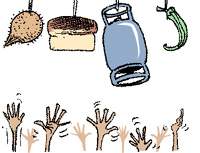| The Sunday Times Economic Analysis By the Economist | ||||||
|
The spiralling cost of living: No easy fixes By the
Economist The government's popularity is at stake, if no tangible efforts are made to contain prices. In a context of experiencing spiralling prices in recent weeks, it is difficult to believe that the inflation rate decreased last year to 9.6 percent from 14.2 percent in 2001, according to the Colombo Consumers 'Price Index (CCPI). According to
the Colombo District Consumer Price Index (CDCPI) the rate of price
increase was still lower. Last year's inflation rate was only 6.8
per cent. There are statistical reasons why the indices appear to
disclose lower than consumer's perceived price increase. Consumers too
tend to perceive overall price increases to be high owing to their
perception being based on a few prices that affect them. Nevertheless,
in fact prices have increased significantly even on the basis of
these indices. In the last two years consumer prices have increased
by about 25 per cent, though the rate of inflation declined last
year compared to the previous year. Although the annual rate of
inflation decelerated, according to both indices, they disclose
a sharper rise in prices in December than in the previous month. There has also
been a definite higher increase in prices in the latter months of
the year compared to the earlier months of the year. In December
alone prices rose by 2.5 per cent over the previous month according
to the CCPI and were 11.3 per cent higher than the prices prevailing
in December 2001. According to the Central Bank, the main contributory
factor for the increase in the CDCPI in December was the increase
in food prices. Most varieties
of vegetables, fish, some varieties of rice, coconut and eggs increased
during the month. December is a month of higher prices of consumer,
especially food items, but last December's price increases appear
to have been even more than the usual seasonal increase. The fact
that they were over 11 per cent more than the prices of the previous
December is indicative of this. What is worse
is that prices have continued to rise since December. The gas price,
petroleum price, wheat flour and bread price increases are most
significant. Promises of bringing down consumer prices have once
again proved futile. Indications are that prices would rise further.
There are also gathering dark clouds that portend soaring prices
in the near future. If war breaks out in the Middle East, prices
would surely escalate fast. Since Bush
and Blair are adamant on attacking Iraq, neither waiting for the
UN inspection team's results nor heeding the United Nations nor
the voice of their own people, war appears to be a matter of time.
Then prices will sky rocket, especially as a result of increased
oil prices. The worse case
scenario projects oil prices to rise from the current US$ 32 per
barrel to as much as US$ 80. There are fundamental
reasons why prices have increased and will continue to increase.
Foremost among these is the significance of imports in our consumption.
These prices rise, both due to increases in international prices
and the depreciation of the currency. In addition, domestically
produced goods too have a significant import content. Increases
in fuel, electricity and gas prices result in spiralling cost-push
inflation. The high cost
of domestic agricultural produce is a significant factor in increasing
food costs. The costs of producing food are much higher in the country
than among neighbouring countries. For this there are complex reasons
and no simple solution is possible. Post harvest
losses too are large and marketing of agricultural produce leaves
much to be desired. These add to the marketing margins, depressing producer prices and raising consumer prices. Freer imports would reduce consumer prices, but would affect the large farming community adversely, increase poverty and create social tensions in rural areas. What these imply
is that if consumer prices are to be contained, considerable thought
should be given to several aspects of economic policy. There are
macroeconomic issues as well as sector issues that have to be looked
into. Neither a reliance on market forces nor price controls are
likely to automatically yield results. There is no easy fix. The moot question is whether the government is taking a serious look at this vital question. The public seems to think the government is unconcerned with the plight of the poor consumers. |
||||||
Copyright © 2001 Wijeya Newspapers
Ltd. All rights reserved. |
